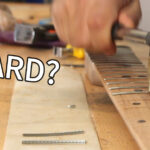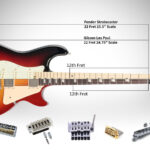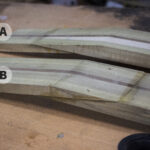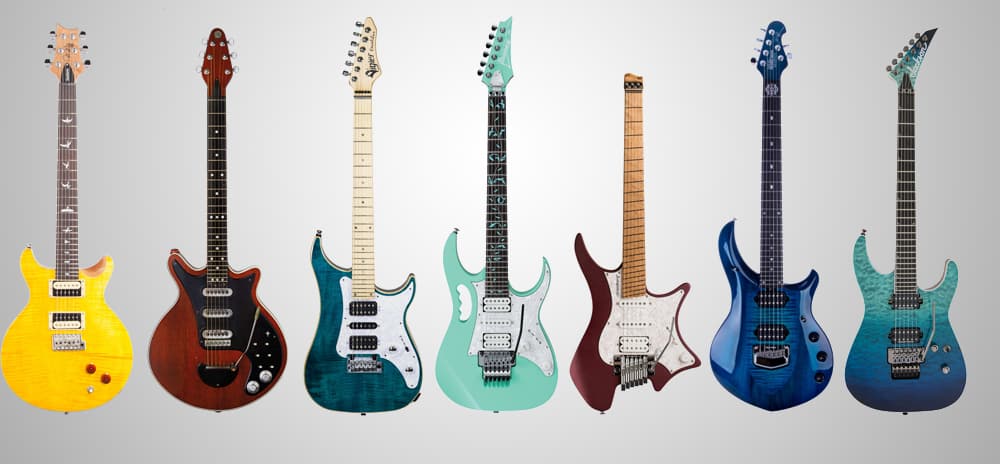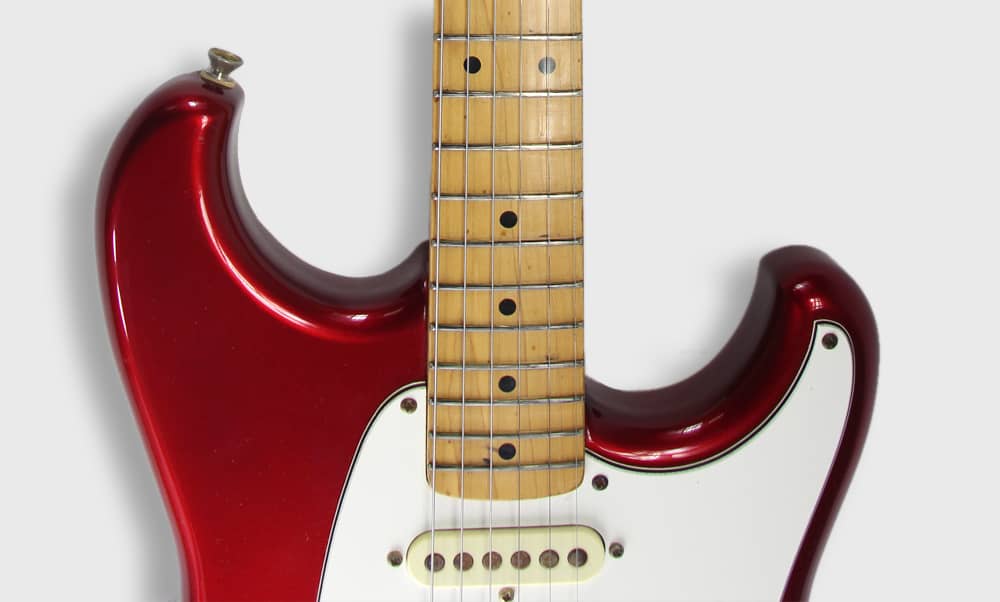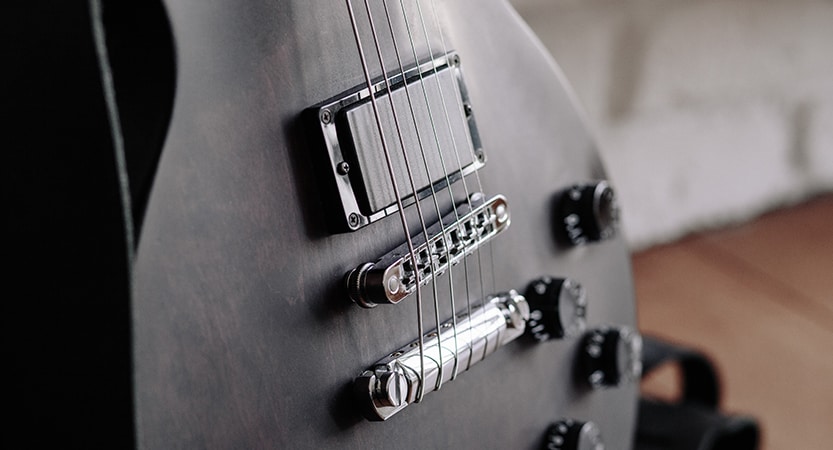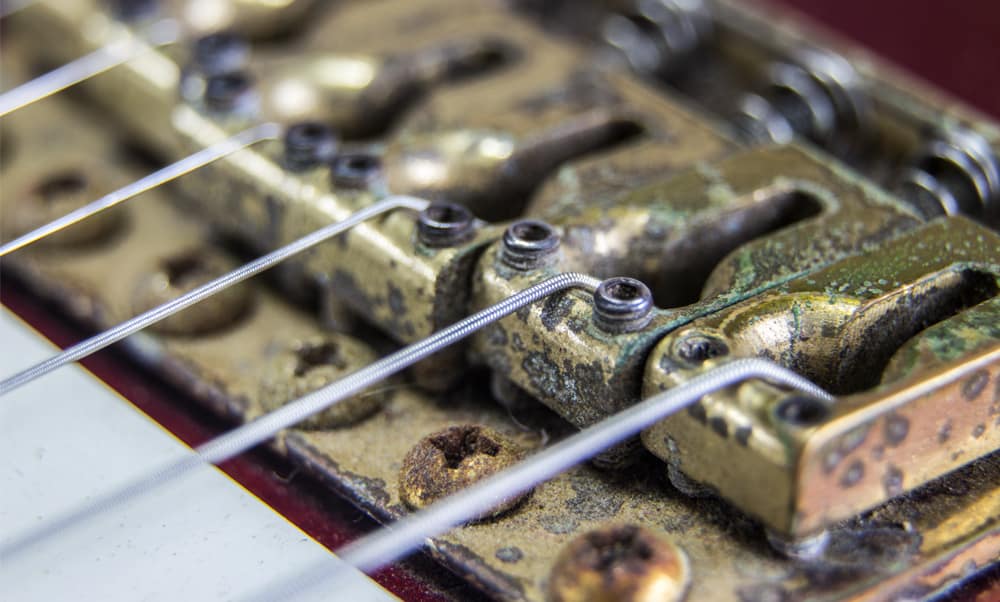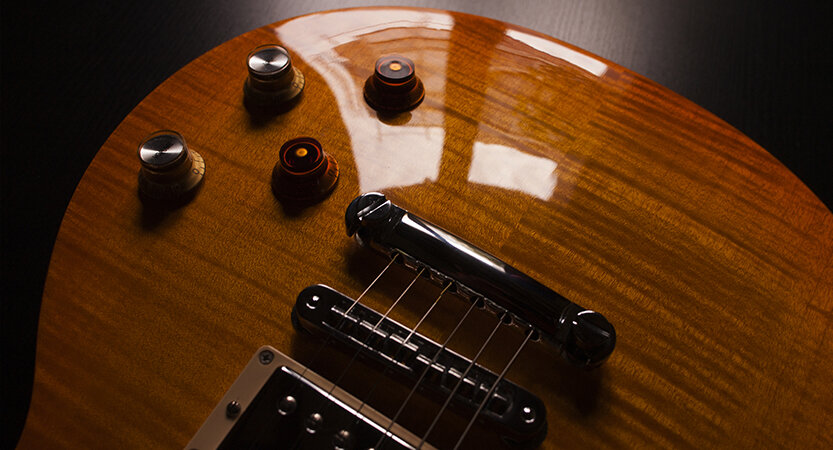Whether you are shopping for a new guitar, a kit guitar or if you are thinking of building it on your own you may have come across guitars with 24 frets and you may be wondering if that is the way to go. At first glance you would say sure, 24 frets would give you a bigger range of notes, but is there any reason you would not want that?
The vast majority of guitars have 22 frets, a few models like older Fenders, have only 21 frets but more and more 24 fret guitar s are popping out in stores in the last few years. We’ll take a look at the pros and cons of having those two extra frets so we can weigh them and make a more calculated decision. We’ll take a look at the musical, practical aspect, the aesthetics and the construction aspects of it. I am also going to try and stick to facts and stay away from personal preferences and myth.
22 Fret Vs. 24 Fret Guitars
First let’s look at the similarities
Similar Scale Length
Different guitars may have different scale lengths but the addition of the two frets will not change the scale length. The scale length is the measured from the bridge to the nut and is defined as twice the length between the nut and the twelfth fret. So similar guitars such as a 22 fret Stratocaster and a 24 Supercaster will still have the same 25.5” scale length. Lets take a look at the fret spacing on a 25.5” scale length guitar.

The 22nd fret will be in the same place whether you install the 23rd and 24th frets or not. The same will of course be true to any other scale length. You don’t ‘squeeze-in’ the extra two frets, you add them after the 22nd.
The perfect scale length for a 24 fret guitar
The answer to that should be obvious by now. Just as there is no ‘perfect’ scale length for standard guitars, there is no difference for a 24 fret guitar. If you are a fan of the 24.75” Gibson scale you would probably prefer your 24 fret version to be just that. PRS for example have decided to split the difference (between Fender and Gibson) and make their guitars, including the custom 24 fret, at a 25” scale.
So what are the differences between a guitar with 22 frets and one with 24?
(Slightly) Bigger Range
Adding two more frets will result in an extra high playable tone. In standard tuning the high E string will have two full octaves and the 24th fret will play an E note, two half tones more than a standard 22 fret fingerboard. Although you are getting one full tone more on each of the strings, you will actually only get the ‘extra’ note on the high E string as the rest of them can be found on a 22 fret guitar as well. We can argue about the tonality of the same note on different strings and neck positions, but we are talking about the same notes. No need to bend your High E string at the 22nd position for an E note, it’s right there, at 24.
Neck pickup position
The second difference, and probably the one that has the largest effect on the sound of the guitar is the position of the neck pickup. Since we established that the scale length remains the same, when we add two more frets, we have to push the neck pickup towards the bridge. Pretty much any guitar (that has more than one pickup) pushes the neck pickup as far as possible to the neck. Those two extra frets will add 0.781” (19.84mm) to the neck on a 25.5” scale and a hair less on shorter scales.
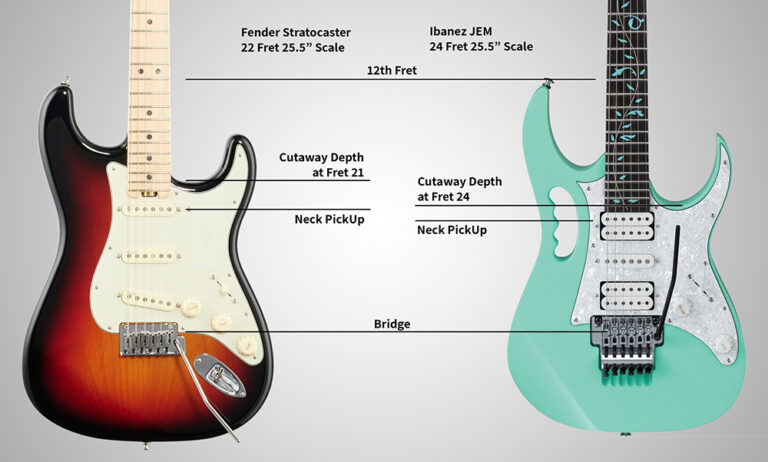
Pickup position and tone quality
Any note played on a guitar will have the biggest vibration and thicker sound right in the middle. In open strings that will land exactly at the twelfth fret. By definition the closer a pickup will be to that midpoint, the fuller, thicker and bigger the tone it will give. This is very apparent when comparing any two similar pickups at the neck or bridge position. The bridge will always give a brighter and thinner quality sound. In most cases you would want both qualities and the ability to switch and combine them for either solo vs rhythm playing or just for variety.
Going back to our 24-fret guitar, the neck pickup will have to pushed towards the bridge more than the equivalent to a single coil pickup’s width and therefore will give a slightly, yet noticeably, brighter sound than the original position. There are many other factors determining the sound of a guitar. To really hear the difference, you will of course need to compare similar guitars with similar pickups.
The guitar shape and playability
In most guitars, some extra effort and agility will be required to make good use of the 22nd fret, and adding two extra frets on a standard Strat or Les Paul may render them quite useless. A third difference for 24 fret guitars would have to include better access to those frets. There are two common solutions. If you are trying to maintain an original design you can simply carve into the ‘existing’ cutaway a bit more to give extra room, like the PRS Custom 24. The other option is to build the whole body shape with deeper cutaways to begin with like pretty much all the John Petrucci guitars
Aesthetics
It’s really a minor issue, but I personally just love seeing that two octave two dot mark. It gives a sense of completion, as if two full octaves were always how a guitar was meant to be. If you like collecting guitars, I am sure you have at least one guitar you have bought solely based on it’s looks and you keep it regardless of how much you play it…
Which is better than?
Many known guitarists will stick to the standard 22fret guitar because they like the classic, traditional sound or just because they don’t feel the need for that extra tone. Others prefer the bigger range and get a 24 fret guitar in spite or because of the different tonality. Ibanez, for example, modeled many of their new 24 fret guitars after Steve Vai’s JEM and he certainly makes use of every single fret he can get his fingers on. The number of frets is only one factor when choosing/ building a guitar and there is no best choice, but only (and maybe not even) a best one for a particular player.
Do I need 24 Frets?
By now you understand the pros and cons of the 24 fret option and you can make an informed decision. The first thing you need to ask yourself is: are you even going to be using the extra two frets. These are pretty high notes and depending on your style and genre of playing, you may never even use them. Classic rock for example, does not ‘require’ 24 frets. The second question is in regards to the sound. Do you mind the ‘sacrifice’ of heaving your neck pickup play slightly brighter than it could have? You may hardly notice it with all the effects, you may actually like it, you may be using the bridge pickup for soloing anyway or it may be out of the question.
Chances are, if you are a beginner, you probably don’t need 24 frets and if you are a seasoned player you just need to give it a try and you will know.
Production 24 Fret Guitars
- Ibanez are probably the largest manufacturer that has really incorporated the 24 fret guitars into their growing line of superstrates that spawned from Steve Vai’s design and (wonderful) whims.
- PRS has also incorporated a nice range of 24 fret guitars into their SE, CE, S2 and custom lines
- Ernie Ball music man has quiet a few models with all John Petrucci Signature models included
- Schecter Guitars has some models such as the Banshee Custom 24 and the Sunset 24 7fr
- Vigier Guitars have had several 24 fret guitars as well as in their new Excaliber line
- Strandberg guitars even have 24 fan fretted guitars
- Charvel and Jackson also have a few models with 24 frets
- The Epiphone LTD Tony Lommi SG
There are probably many more models, but these are probably the more dominant ones.
Construction of a 24 fret guitar
The basic construction of a 24 fret guitar is not really diferent than a standard 22, but you do have to take into account the slightly different proportions. There are a few things to take into account:
Your neck is going to be longer but the distance from the 22 fret to the bridge is the same as it would have been on a 22fret guitar (regardless of the scale length you choose)
The Neck Pickup is going to be about 0.78” (20mm) closer to the bridge, so correct your templates before routing the body.
The Neck pocket is probably going to need adjustment or repositioning
You will need to provide a deeper cutaway or other means to better access the last frets
Make sure your unconventional neck has enough support
There are a few ways you can approach it
The easy way
Pick a guitar design that already incorporates 24 frets and just copy it. Good candidates would be any of the newer Ibanez designs, the Music Man Majesty or siblings or any other guitar which has very deep lower cutaway.
The ‘lazy’ way (The PRS method)
Take any of your favorite body designs, deepen the neck pocket and make the cavity for the neck pickup in the new position.
Carve in to the lower cutaway without going all the way through, just enough to let your fingers deeper access.
The ‘Neck-Through’ way
A through neck will have the center of the body, the neck and the headstock as one piece or one multi-laminated piece, offering greater stability and eliminating the issue of connecting or supporting the neck as a separate unit. Building a Neck-Through guitar will inherently solve any structural issues and will enable you to cut-away as deep as you want with no practical consequences. Once the center piece, the neck and body, is built, the fretboard, the bridge and the pickups can be attached to it and the rest of the body has structural effect on the guitar. Aesthetics and tone can be argued about.
The original design
Create your own original design which will have all the above-mentioned parameters and concerns solved. This is not for everyone, and everyone would want it.
Can I fit a 24fret neck on a standard 22 fret guitar
Many people would like to just trade the standard 22 fret neck with an aftermarket 24 fret neck. In theory this can be accomplished but it’s nothing but straight forward. Here are some issues you may incounter, (and how to fix them):
You need to find a neck with the same scale length as the old one, or more adjustments will be required.
The new neck will probably not be perfect fit and may require shimming, if too large, or routing if too small.
If you just slap on the 24fret neck (assuming the neck pocket fits) the longer neck will push the nut further and your scale length has just changed. To fix this you will probably need to reposition your bridge and bridge pickup.
- To avoid this and maintain the correct scale length, you will need to rout the neck pocket so the 22nd fret of the new neck will be in the exact same distance from the bridge as the one in the old neck.
- This will also cause the neck pickup to require routing and shifting a bit towards the bridge.
- Depending on the type of guitar, you may also now have a problem reaching your new frets. A Gibson SG for instance, may lend itself naturally to reach those higher notes, but a binded guitar such a Les Paul, will not make it easy.
In short, in order to fit a longer neck to a particular guitar you will need to make some serious adjustments involving repositioning either of the neck and neck pickup or the bridge and bridge pickup. With either choice you will need some routing and maybe left with visible ‘scars’ to the body.
Can I compensate for the position of the neck pickup
The short answer is no. In the same conditions and compared to an identical guitar with 2 less frets, the position of the neck pickup closer to the bridge will make it somewhat brighter. This may be marginal in some guitars and ears and may be detrimental to others. There is no way to change that. Having said that, there are plenty of ways to try and make up for that thickness and deeper tone, from thicker strings, a different pickup, an amplifier or a wide range of sound effects and pedals.
Conclusion
24 Fret guitars may become the standard in the future when 22 fret guitars will be ‘vintage’. Properly made 24 fret guitars benefit from the extra range of notes without compromising the playability and comfort. The extra two frets will leave slightly less room for the neck pickup (and the middle one if exists) and therefore will have a slightly brighter sound to those (no effect whatsoever on the bridge pickup).
If 24 frets suit your playing style and it sounds fine to you, go for it.
If you never see yourself using that part of the neck anyway and you enjoy the thicker sound of the neck pickup, don’t bother with it.
If you are building a guitar, the same consideration apply, but the construction itself although does need to be slightly adjusted, is not necessarily more difficult.

